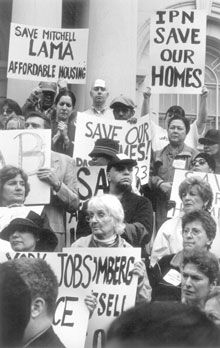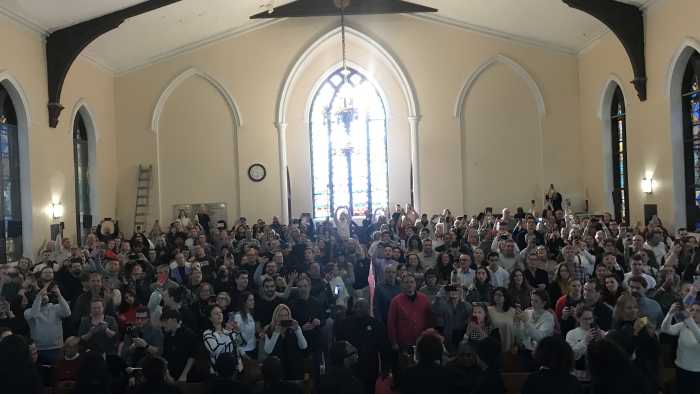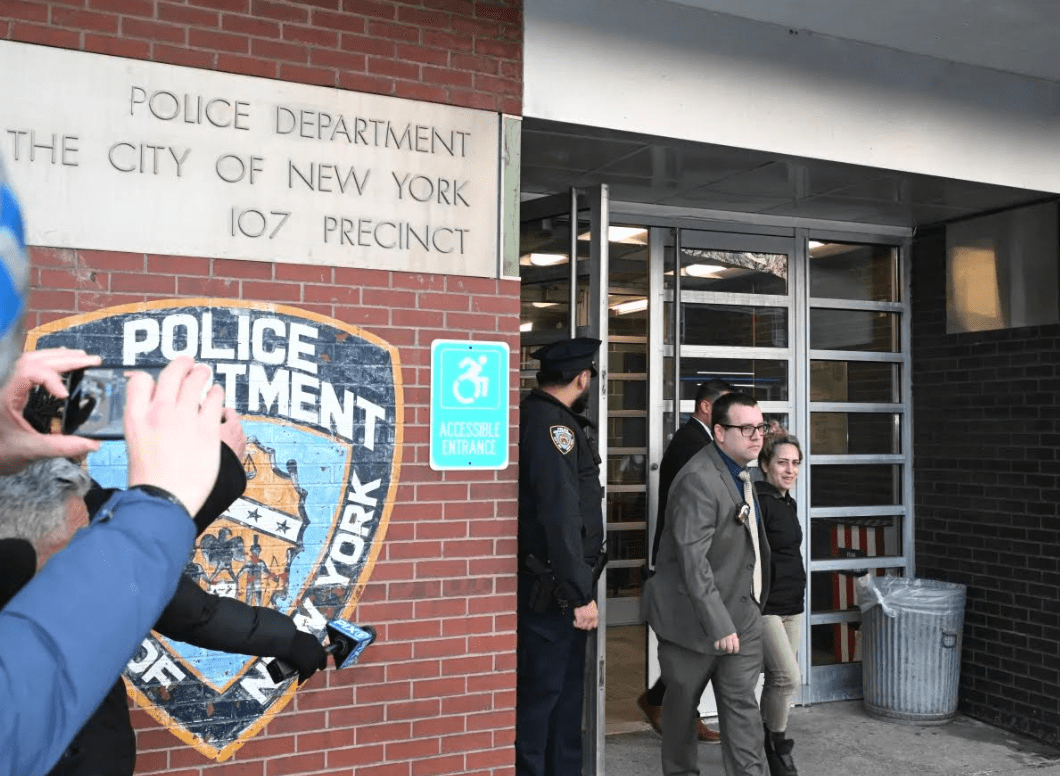By Albert Amateau
Reader Services
Join our forums | Email our editor | Report Distribution Problems
Read our previous issues
Volume 73, Number 27 | November 05 – 11, 2003
Mayor has a Mitchell-Lama proposal too
The Bloomberg administration last week proposed to back state legislation that would put Mitchell-Lama rental buildings in the rent-stabilization system when they leave the program.
The proposal was made public the same day the City Council held its first hearing on a bill that would make it more expensive and difficult for landlords of many Mitchell-Lama buildings to leave the program and charge market-rate rents.
Mitchell-Lama tenants of Independence Plaza North who rallied on the steps of City Hall on Wednesday in support of the proposed Council bill said they were glad the mayor had taken a stand on the issue, but they were skeptical about Mayor Bloomberg’s chances of pushing the bill through the Republican-dominated state Senate.
“We’ve had numerous bills like that pass the Assembly in Albany but the Senate always kills them,” said John Scott, a vice president of the I.P.N. Tenants Association. “The timing of the mayor’s announcement seems to say that we don’t need our bill.”
Indeed, Assembly Speaker Sheldon Silver said later that it would be up to the mayor to persuade his allies in the Republican-controlled state Senate to pass the bill. “Ours is stronger,” Silver said of the Assembly bill, “but let him get the Republicans to pass his bill and we’ll pass it too.”
Moreover, state Senator Martin Connor, whose district includes I.P.N., testified in favor of the Council bill on Oct. 30, but said the mayor’s bill would “have a long wait” in Albany. “I serve in the state Senate and I can tell you the likelihood of passing legislation opposed by the real estate lobby is nil,” Connor said. “The City Council legislation, Intro. 523, is needed and needed now.”
The proposed Council legislation, introduced in July by City Councilmember Alan Gerson and co-sponsored by Council Speaker Gifford Miller and 34 other councilmembers, including Christine Quinn and Margarita Lopez, would affect an estimated 25,000 Mitchell-Lama units in the city that are in the process of leaving the program. These include 1,340 apartments at Independence Plaza North in Tribeca and 420 apartments in the West Village Houses in the Village.
I.P.N. and West Village Houses tenant associations want to acquire the projects and create limited-equity co-ops. The Council legislation, entitled “The Mitchell Lama Conversion Protection Bill,” does not mention rent stabilization but is intended to force owners to negotiate many issues with tenants before city-supervised Mitchell Lama buildings leave the program.
Marilyn Davenport, a vice president of the Real Estate Board of New York, testified against the Council legislation and also said later that provisions in legislation like the mayor’s proposal should be entirely voluntary. Real estate industry representatives, including Edward C. Wallace, attorney for Stellar Management and its principal, Laurence Gluck, the new owner of I.P.N. who plans to take the complex out of the Mitchell-Lama program in a year, had even harsher words for the Council bill.
“It is blatantly illegal and holds out false hopes to tenants,” said Wallace, who predicted that the bill would not survive court challenges. “It violates the home rule and preemptive principals of the New York State Constitution.”
But supporters, including Clayton Gillette, professor of contract law at New York University Law School, and Chad Marlow, a Village resident and lawyer who last year drafted a bill similar to the one in the Council now, testified that the Council bill is on solid legal ground.
The Mitchell-Lama law, enacted 43 years ago, allows landlords to leave the program and charge market-rate rents after 20 years if they pay off outstanding mortgages and taxes.
The proposed legislation would apply to Mitchell-Lama rental apartments supervised by the city Department of Housing Preservation and Development and occupied after Jan. 1, 1974. Such buildings are not now subject to rent stabilization if landlords buy out of the program. Under the Council bill, an impact study on the effect of a building’s leaving Mitchell-Lama would examine the rent increases that tenants would have to pay, the availability of affordable housing and the number of families likely to be displaced as a result of higher rents. The owner would then have to pay for mitigating any adverse effects on tenants.
H.P.D. would also have to determine whether the owner had substantially complied with Mitchell-Lama laws and regulations. If the agency finds the owner did not comply, the new legislation would impose a civil penalty equal to three times the amount of damages suffered by tenants or the city.
At the hearing on the bill last week, H.P.D. Commissioner Jerilyn Perine agreed with opponents that Council Intro. 523 was flawed and “inconsistent with state law, making its future uncertain.”
Perine said the Bloomberg proposal recognizes the fear of Mitchell-Lama tenants that high rent increases would threaten them with eviction.
The Bloomberg administration “will seek the passage of state legislation that will extend rent-stabilization protection to all Mitchell-Lama rental buildings that were occupied after 1974, thereby ensuring that such tenants will be protected from significant rent increases and arbitrary eviction,” Perine said.
At the same time the city-sponsored bill if passed by the state Legislature would provide Mitchell-Lama owners with real estate tax exemptions on each apartment in rent stabilization if tenants, like some at I.P.N., are not entitled to other subsidies such as federal enhanced vouchers.
In other neighborhoods where market rents would be similar to current Mitchell-Lama rents, owners would be exempt from the six percent cap on returns if they stay in the program. In lower-rent neighborhoods where Mitchell-Lama projects have a hard time getting financing for rehabilitation, the mayor’s affordable housing plan, announced last December, provides $50 million for low-cost loans, Perine noted.
Gerson, however, remained skeptical about the mayor’s proposal in the state Legislature. “What if the bill doesn’t pass?” he asked Perine. “What is plan B?”
Perine answered, “We’ll do everything we can to pass the bill. There is no plan B.” The commissioner added, “We have a good chance of getting it passed now; there is an urgency about Mitchell-Lama now.”
Nevertheless, Councilmember Quinn recalled that she had spoken in vain with state Senate Majority Leader Joseph Bruno during the last legislative session about help for West Village Houses’ leaving the Mitchell-Lama program. “This should have been done sooner rather than later,” said Quinn.
A spokesperson for Bruno’s office said the majority leader had not yet read the mayor’s proposal and would not comment.
Davenport, the Real Estate Board of New York vice president, said later that changes in state Mitchell-Lama rules should not be mandatory. “It’s very problematic,” she said of the main provisions of the mayor’s proposal. “Changing the rules now would be a breach of faith resulting in a loss of trust in government and would discourage participation in affordable housing projects,” she said.
However, Victor Bach, senior housing analyst for the nonprofit Community Service Society, said the Bloomberg plan to transition to rent stabilization and the Council bill are not mutually exclusive. “They complement each other,” Bach said. “We’re pleased to see the mayor get behind the push to protect Mitchell-Lama tenants. And the Council legislation opens the door for tenants and owners to negotiate.”
Both the Council bill and the mayor’s proposal would take effect now rather than the dates of passage in order to include buildings currently in the process of leaving Mitchell-Lama protection.
Kathryn Freed, an I.P.N. resident and a former city councilmember, said the Tribeca residents’ pioneering efforts should be rewarded by keeping housing affordable. “Our homes are totally on the line,” she said. “We came to Lower Manhattan without schools and without even a supermarket.” The Council bill, she added, would enable I.P.N. to remain a community where rich and poor can live.
Among I.P.N. tenants who testified in favor of the Council bill was Jose Torres, former light heavyweight boxing champion (1965-’67) and an I.P.N. tenant for nearly 30 years. “The most important thing for me is the diversity at I.P.N.,” he said.







































